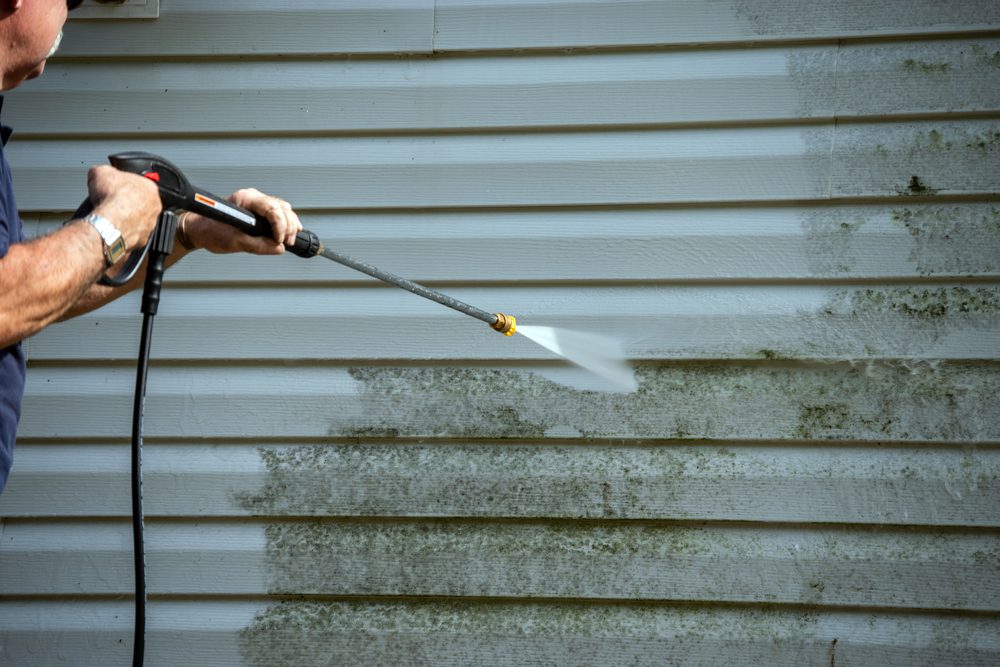
Vinyl siding is one of the most popular exterior finishes for homes in the U.S. It’s affordable, low-maintenance, and visually appealing. But over time, it collects dirt, dust, mold, mildew, algae, and even insect debris — especially in shaded or humid areas.
Power washing seems like a great way to restore your vinyl’s shine, but there’s a catch: done wrong, it can damage your siding or force water behind the panels. 😬
This guide will walk you through how to safely power wash vinyl siding without causing costly damage, using the right tools, settings, and methods to get your home looking brand new again. 🏡✨
💡 Is Power Washing Safe for Vinyl Siding?
Yes — when done correctly, power washing is a safe and effective way to clean vinyl siding. But too much pressure, the wrong nozzle, or incorrect spraying technique can:
- Crack or warp the panels
- Strip off protective coatings
- Force water into the wall cavity
- Leave streaks or residue
That’s why it’s essential to learn how to clean vinyl the right way before firing up your machine.
🧰 What You’ll Need
Here’s your checklist for a safe vinyl siding clean:
- Electric or gas pressure washer (1,300–2,500 PSI max)
- 25° or 40° nozzle tip (wide spray pattern)
- Vinyl-safe detergent (biodegradable preferred)
- Garden hose for pre-wetting and rinsing
- Extension wand (for second stories)
- Protective gear (gloves, goggles, closed-toe shoes)
⚠️ Avoid using bleach or harsh chemicals not labeled for siding. These can cause discoloration and runoff damage.
Browse Amazon For Vinyl-Safe Detergent And Pressure Washing Equipment Here
🚫 Avoid These Common Mistakes
Before we dive into the step-by-step, let’s address what not to do when pressure washing vinyl:
- ❌ Don’t spray water upward — it can get behind the siding
- ❌ Don’t use more than 2,500 PSI — it’s overkill and risky
- ❌ Don’t use a 0° or 15° nozzle — too focused and strong
- ❌ Don’t ignore nearby windows, doors, and outlets
- ❌ Don’t forget to rinse — leftover detergent can stain
🎯 A gentle, top-down approach always works best.
🧽 Step-by-Step: Safely Power Washing Vinyl Siding
Let’s break it down into easy, safe steps:
Step 1: Inspect the Siding 👀
Before doing anything, walk the perimeter of your home and look for:
- Loose or cracked panels
- Gaps in caulking
- Exposed electrical outlets
- Paint or trim near siding that might peel
Fix or cover these issues before starting.
Step 2: Pre-Wet the Siding 💧
Use a garden hose to wet the siding from top to bottom. This prevents the detergent from soaking in too fast or drying before you can rinse.
Step 3: Apply Detergent 🧴
Use a pressure washer soap injector or pump sprayer to apply siding-safe detergent. Work in small sections (10–15 ft at a time) and apply bottom to top to avoid streaks.
Let it sit for 5–10 minutes to loosen the grime — but don’t let it dry.
Step 4: Begin Washing (The Safe Way) 💦
Use your 25° or 40° nozzle and hold the wand at a 45° downward angle, spraying from top to bottom to avoid forcing water underneath.
- Stay 12–18 inches away from the surface
- Use smooth, overlapping passes
- Never point the nozzle into seams or up under panels
🔁 Take your time — it’s not about brute force, it’s about steady technique.
Step 5: Rinse Thoroughly 💦
Immediately after washing, rinse each section with clean water from a hose or low-pressure setting on your washer. Rinsing removes all detergent, dirt, and residue — and helps prevent streaks.
🌿 Rinse nearby plants and windows too, just in case!
🧠 Pro Tips for Better Results
- Wash on a cloudy or cool day to avoid detergent drying too fast
- Use a ladder or extension wand for high areas (don’t angle the spray upward)
- Cover outdoor outlets with plastic before starting
- Clean siding once a year to prevent buildup and staining
- Add a vinyl-safe mold inhibitor to your detergent if algae is common in your area
📸 Take before-and-after photos — the difference is often dramatic!
❓ What About Soft Washing Vinyl?
Soft washing is a low-pressure method that uses biodegradable detergent and gentle rinsing. It’s ideal for:
- Older vinyl homes
- Delicate trims or painted surfaces
- Second-story areas with mold
Professionals often use this method instead of traditional power washing — and it’s a great alternative if you’re worried about damage.
🔧 When to Call a Pro
Hire a professional if:
- Your home is two stories or taller
- The siding has years of neglect or deep mold
- You’re not comfortable using power equipment
- You want a combo service (roof + siding + deck, etc.)
Pro washers use commercial-grade equipment, specialized cleaners, and trained techniques that deliver fast, uniform, and safe results.
✅ Final Thoughts
Vinyl siding is tough — but not invincible. Done right, pressure washing can make your home sparkle like new. Done wrong, it can leave permanent damage and water behind your walls.
So if you’re tackling this job yourself:
- Use the right pressure
- Aim carefully
- Work in sections
- Always rinse thoroughly
And if in doubt, let the pros handle it.
A clean exterior isn’t just about looks — it’s about protecting your investment and giving your home the care it deserves. 💪🧼
Browse Amazon Here For Power Washing Equipment And Accessories



